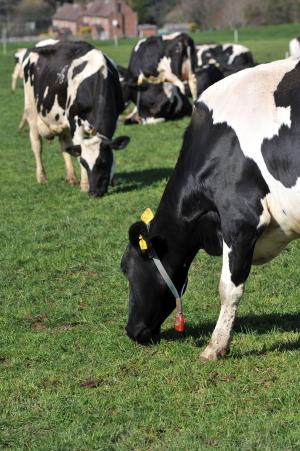GrassCheck returns as prospects for turnout improve
Date published:
Following an exceptionally wet winter, the recent spell of settled weather has been welcomed by farmers across Northern Ireland. Fields that were waterlogged throughout February are now, in most cases, able to carry machinery and livestock

However, despite the exceptionally high rainfall during the last few months the winter was mild, and as a result, some farms are currently carrying good covers of grass. In these cases, consideration should be given to grazing these covers before grass growth really accelerates. Decisions made during the next few weeks have the potential to impact on grass quality well into the grazing season.
The AgriSearch and DARD funded GrassCheck project has returned to provide weekly grass growth information and to help farmers make informed and timely grassland management decisions throughout the 2014 grazing season.
GrassCheck returns
Although fertiliser is normally applied to the GrassCheck sites in early/mid-February, the water logged soils meant that the first fertiliser of 2014 was not applied until 28 February, with urea supplying 28 kg of nitrogen per hectare applied (equivalent to ½ bag urea per acre). Weekly cutting has now started, and a further 28 kg of nitrogen per hectare (as urea) will be applied before the end of March.
This year the weekly bulletins will provide information on actual grass growth and quality as measured at Hillsborough and Greenmount, and will compare this year’s growth with the long-term average. In addition, regional grass growth predictions will be provided each week for north, south, east and western regions of Northern Ireland. These predictions will be made using a grass growth model, which takes account of short and medium term weather forecasts. In addition, grassland management on a number of dairy farms across Northern Ireland will be highlighted weekly through the ‘Grazing Management Focus.’ Information will be provided on animal performance, grass covers, stocking rates, and grass supply, while decisions being taken on these farms during periods of grass surplus or deficit will be explained.
Winter growth and current grass quality
Given the mild temperatures throughout the autumn and winter, with only a few frosty mornings to date, grass quality is generally excellent in many areas. For example, samples of grass analysed in mid-March at Hillsborough indicated that grass dry matter content was 20%, crude protein content was 24%, and metabolisable energy content was 12.1 MJ per kg of dry matter. Winter growth rates have also been measured at a few sites, with an average growth rate of 2.0 kg dry matter per hectare per day measured at Hillsborough from mid-November until early March and close to 3.5 kg dry matter per hectare per day measured at Downpatrick. This represents an increase in grass cover over the winter of over 400 kg dry matter per hectare, and it is likely that fields closed earlier (early October) will have accumulated even more cover than this.
Given current grass covers and grass quality, there is an opportunity for many farmers to get cows out grazing for a few hours daily as soon as ground conditions permit. Delaying turnout now will allow grass covers to accumulate further, and with soil temperatures since early March being 6.0oC or above, grass is actively growing. Grass growth rates of approximately 30 kg dry matter per hectare per day have been measured during late March and early April within the GrassCheck project in the past, and this can change grass supplies quickly. The aim must be to setup the grazing platform so that there is high-quality grass available for grazing for the second rotation and most farms should be targeting to complete their first grazing cycle by mid to late April. Allowing grass covers to continue to accumulate will make achieving this target increasingly difficult.
The weekly bulletins provided by the GrassCheck project are designed to provide farmers with key information on current and predicted grass growth and quality, and guidance on dealing with difficult situations which may arise. Use the information provided by GrassCheck to help you make timely grazing management decisions with confidence. A delayed response to grass surpluses or deficits will increase the costs of producing milk and meat from grazed grass as either additional supplements will have to be fed, or potential milk yields or growth rates will not be achieved.
by Andrew Dale, Agri-Food and Biosciences Institute, Hillsborough and Norman Weatherup, College of Agriculture, Food and Rural Enterprise, Greenmount Campus
Notes to editors:
AFBI carries out high-quality technology research and development, statutory, analytical, and diagnostic testing functions for DARD and other Government departments, public bodies and commercial companies. AFBI's Vision is “Scientific excellence in Northern Ireland … serving the world”.All media enquiries to AFBI Press Office